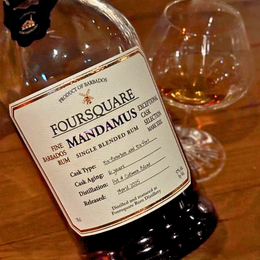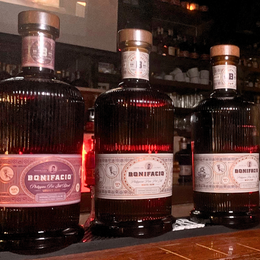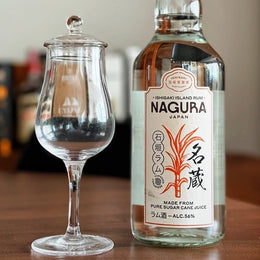
Have you ever wondered what it is like to smell or taste someone’s personality and experiences? Are our senses even capable of such a thing?
One concept that has historically contributed to the development of the human chemosensory system is “terroir.” In 2021, a study by Kyraleou et al. sought to examine the volatile compounds that influence sensory perception when tasting single malt whisky. The findings of the study clearly indicate that the phenotypes of the raw materials used for whisky have an impact on what can be smelled and tasted with new make spirit (Kyraleou et al. 2021). According to the authors, “this study has clearly demonstrated variations in the contribution of the aroma active volatiles and sensory attributes in these new make spirits, which reflect changes in barley growth in relation to environmental elements including soil nutrients and prevailing seasonal weather patterns; therefore, it reveals a 'terroir’ effect.'" (Kyraleou et al. 2021:20).
Terroir. Any truly serious spirits enthusiast should know about that term.
Merriam-Webster defines “terroir” as "the combination of factors including soil, climate, and sunlight that gives wine grapes their distinctive character." Since the term is of French origin (it directly translates to "land"), one can easily recognize the connections that the concept has with French cultural products. Bruno Prats, a French oenologist and former winery owner, provides a more nuanced definition:
"The French term terroir captures all the natural conditions that influence the biology of the vine and consequently the composition of the grape itself. Terroir is the confluence of climate, soil, and landscape, the interaction of an infinite number of factors: Night and day temperatures, rainfall distribution, hours of sunshine, slope, and soil permeability, just to name a few. All these factors react with each other and form what the French winemaker calls terroir in each individual part of a wine-growing region."

However, as shown by Kyraleou et al.'s (2021) study, wine isn’t the only consumable product with flavors that are impacted by geography or the environment. Because of the importance of regionality in other products, the concept of terroir has easily found itself being applied in other industries. I first learned about terroir during the days when I was seriously learning about tea. Similar to its use in assessing wine, the concept of terroir is used to gauge the character of tea – whole leaves from camelia sinensis and not the tea bags or tisanes that are ridiculously marketed as real, quality tea – based on the specific regions and elevations that the leaves are sourced from.
The concept's application in spirits is the same. Drinks writer Dave Broom (2016) describes terroir as a "sense of place," a fingerprint that affects the flavors in distilled spirits. In agreement with this idea is La Maison & Velier's marketing and export manager Daniele Biondi, who explains that terroir is expressed through the preservation of the production process (Motion, 2021).
While terroir has already been subject to much research and discussion, I'm intrigued by a related concept that, as of now, has not been discussed as much: social terroir. Foursquare Rum Distillery master distiller Richard Seale seems to reference this concept when talking about the importance of "know-how" in the creation of cultural products. Whether in interviews or his social media posts, Seale often explains that Bajan rum has geographical ties to Barbados not only because of factors like raw materials and climate but also because local producers have an intimate understanding of and relationship with the rum they make.
Sjölander-Lindqvist et al. (2019) tackle the concept of social terroir more concretely in their study, where they explain that terroir in the context of craft beer largely extends beyond ingredients and the natural environment. They define social terroir as consisting of "social ties to place and community," and they conducted qualitative research on the craft beer industry in Sweden to examine how producers' "different perspectives and sets of values are reflected in the way they conceptualize and carry out their work" (Sjölander-Lindqvist et al. 2019:150-151). The study argues that the craft beer industry, characterized by much creativity and innovation, is an "inherently social practice that is part of a particular sociocultural milieu," involving the ways that producers' choices are informed by their localities, beliefs, and relationships (Sjölander-Lindqvist et al. 2019:158).
Drinks writer Becky Paskin (2020) also posits that spirits like whisky are influenced most significantly not by environmental influences. Instead, producers embody themselves – their "experiences, interests, and passions" – in the spirits they create. Paskin explains that even when whiskies reflect distinct house styles, the artistic intent of distillers and blenders plays a dominant role. She even references the ideas of Lesley Gracie, the master distiller of Hendrick’s gin, who explains that “A person’s vision, ambition and creativity can have a stronger impact on what you end up tasting in your glass than the botanicals themselves or where they come from.”
Before I continue, I must briefly digress to make a couple of clarifications. Am I arguing that terroir in the traditional sense is false, misleading, or insignificant? Certainly not. This article is not written as a contribution to the debates surrounding the existence or relevance of terroir. However, I do find merit in developing the discourse surrounding terroir and even expanding it, especially if it helps us seek new ways to understand the products we consume, especially the liquor that we drink.
With that said, I believe that the impact of social terroir might play a part in the phenomenon of many whisky enthusiasts' obsession with acquiring the liquor created by specific individuals even if those individuals work for new brands or distilleries. There have been countless times when I've come across enthusiasts who associate their loyalty not with brands but with industry giants like Billy Walker, Jim Swan, Rachel Barrie, and Jim McEwan. Sometimes, individuals like these end up having a somewhat niche and dedicated following. Might you, dear reader, know of anyone who is consumed by the need to look for Walker’s GlenDronach expressions and have faithfully followed him to GlenAllachie? I can’t deny the romantic allure of this fandom, though, and its impact on me can be seen in the fact that the idea of social terroir is what led me to seek the rum I'll be reviewing today.
Founded by the descendant of American privateer and rum distiller Andrew Cabot (1750-1791), Privateer Rum is a – you guessed it – rum distillery and brand based in Massachusetts, United States, that has been in operation since 2011.
Ever since I got into rum, the United States, obsessed mostly about its national spirit, bourbon, hasn’t really been on the radar. Instead, the countries whose rums I’ve been learning about are mostly in the Caribbean or Europe. Author Fred Minnick (2020) explains that the dearth of attention given to American rum is by design, rooted in regulations that sought to support the bourbon industry. In his article on the resurgence of American rum, Minnick points out that the growth of the craft distilling has helped emphasized the category and the valuable contributions of one particular rum maker: Maggie Campbell.
Campbell’s reputation precedes her. Having a “vision for minimal intervention, best ingredients, and making a dry rum,” Campbell, who already had extensive formal training and experience distilling whisky and brandy, fell in love with rum after reading about its history and distillation process and ended up working as the president and head distiller of Privateer Rum (Jack, 2020). Soon enough, because of the many other kinds of work in the drinks industry that she has been a part of, she was widely regarded by industry experts as someone who has helped American rum compete with rums. In 2021, Campbell pursued a new opportunity, becoming the estate rum manager of Mount Gay, a rum brand owned by Mount Gay Distilleries Ltd. in Barbados.
Her departure from Privateer Rum is one of the reasons I began looking to acquire one of their bottles. I began hearing about her skill and vision, and eventually, I decided that I want to try her creations before they started to leave the market. In essence, I wanted to understand the social terroir that influences her rums. I wanted to, in a way, taste the accumulation of Campbell’s experiences, expertise, struggles, philosophies, and choices at the moment when she decided that the rum was ready for bottling. What better way is there to learn about American rum than to seek the work of the individual who is labeled as its savior, I thought. And, now, here we are.
Privateer’s Navy Yard American rum is one of their single cask releases. For this expression, grade “A” molasses are sourced from Louisiana and Florida, as detailed by writer and educator Matt Pietrek (2017), and are fermented in metal tanks using a proprietary blend of yeast (but still influenced by native yeasts). Compared to how rum is traditionally made in other countries, Privateer ferments at a lower temperature (74-78 degrees) for six days, as opposed to the typical hotter and shorter fermentation in the Caribbean. This particular release is double distilled, first in a Vendome pot still and then in a column still with eight plates. The rum is then diluted to 110 proof (55% strength) and aged in new American oak barrels with #3-level chars before being bottled, when deemed ready, at barrel proof. The bottle I have comes from Barrel #P526 and is at 107.8 proof (53.9% strength). I purchased it for roughly 100 USD.
Privateer Navy Yard American Rum - Review

Color: Light rust.
Nose: Right away: Tootsie Rolls, coffee jelly, and toffee. I get aromas of a specific sugar-coated donut sold by a local brand – Lola Nena's – here in the Philippines but after briefly toasting the donut on a pan. Maple syrup emerges, leading to aromas of burnt cherries, smoked wood, Campari, and a very subtle turmeric. Near the end of the development is a prominent fig note and puto bumbong (Filipino purple rice cakes that are steamed in bamboo and served with coconut shavings and brown sugar).
Palate: Lots of flavors I find in bourbon like caramel, licorice, and oak. Though initially dominant, other notes eventually show up - toasted coconut meat, warm Belgian waffles, anise, and suggestions of thyme and caramelized Saba bananas. Allow it to develop enough, and the palate is bookended by an almost imposing salty and bitter note akin to heavily seasoned arugula.
Finish: There are lingering notes of carrot cake, light caramel syrup, and root beer, as well as a fading tingle from the earlier saltiness/bitterness.
Conclusions:
I adore the nose. It’s complex, engaging, and clearly communicates what I find to be warm emotional memories. The palate’s development did not fully sustain my enthusiasm from the nose. While it was also characterful, I found that too much of it reminded me of bourbon, which prevented me from entirely recognizing the rum’s uniqueness. It doesn’t help that I’m currently in a phase that isn’t too eager to drink bourbon. The salty/bitter note at the end did not resonate with me either. I must stay, though, that I’m grateful that it ended on a positive note, for the finish had pleasant nuances.
Beyond some of the milestones of her career, I know absolutely nothing about Maggie Campbell (I believe the same would be said by anyone who has not personally met her), but I’d say that based on this singular experience, I understand why she’s well-respected in the rum industry. Certainly, I’d agree with many who characterize Privateer Navy Yard as a rum that holds its own ground against rums like those from the Caribbean. It is astounding that flavors associated with bourbon have provided a clear American spin on this rum, and I wouldn’t be surprised this was by Campbell’s design.
Campbell says, “There really isn’t a beginning or an end in distilling” and that “What I make today is intended for years in the future, and what I am tasting now is from years in the past. The experience leaves you unstuck in time…” Privateer Navy Yard has helped me gain a brief experience of Campbell’s social terroir and how it shapes her rum. Now, while there remain some Privateer rums in the market that were made under her stewardship, the impacts of her social terroir on her creations will continue to develop and be expressed in Mount Gay’s future releases. I wonder if her American heritage will show up in her products there, too.
Referenced studies:
- Kyraleou, Maria, Dustin Herb, Grace O'Reilly, Neil Conway, Tom Bryan, and Kieran N. Kilcawley. 2021. "The Impact of Terroir on the Flavour of Single Malt Whisk(e)y New Make Spirit. Foods 10:443.
- Sjölander-Lindqvist, Annelie, Wilhelm Skoglund, and Daniel Laven. 2019. "Craft beer building social terroir through connecting people, place and business." Journal of Place Management and Development 13(2):149-162.

The Brown Dram
A Filipino living in Metro Manila, Jigs is a whisky and rum enthusiast. His passion for spirits has led him to develop interests in photography and, now, writing. Reach him and check out his work on Instagram @thebrowndram!







